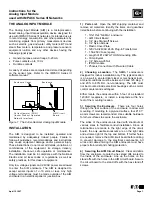
© National Instruments
|
7-9
Low Frequency with One Counter (Averaged)
In this method, you measure several periods of your signal using a known timebase. This method
is good for low to medium frequency signals.
You can route the signal to measure (F1) to the Gate of a counter. You can route a known
timebase (Ft) to the Source of the counter. The known timebase can be 80MHzTimebase. For
signals that might be slower than 0.02 Hz, use a slower known timebase.
You can configure the counter to make
N
+ 1 buffered period measurements. Recall that the first
period measurement in the buffer should be discarded.
Average the remaining K period measurements to determine the average period of F1. The
frequency of F1 is the inverse of the average period. Figure 7-11 illustrates this method.
Figure 7-11.
Low Frequency with One Counter (Averaged)
High Frequency with Two Counters
In this method, you measure one pulse of a known width using your signal and derive the
frequency of your signal from the result. This method is good for high frequency signals.
In this method, you route a pulse of known duration (T) to the Gate of a counter. You can
generate the pulse using a second counter. You also can generate the pulse externally and connect
it to a PFI or RTSI terminal. You only need to use one counter if you generate the pulse
externally.
Route the signal to measure (F1) to the Source of the counter. Configure the counter for a single
pulse-width measurement. If you measure the width of pulse T to be
N
periods of F1, the
frequency of F1 is
N
/T.
F1
Ft
F1
Interv
a
l
s
Me
asu
red
G
a
te
S
o
u
rce
B
u
ffered Period
Me
asu
rement
Aver
a
ge Period of F1 =
N
1
+
N
2
+ …
N
K
K
Fre
qu
ency of F1 =
N
1
+
N
2
+ …
N
K
K
×
Ft
Ft
T
1
T
2
…
T
K
1
Ft
×
1
2
...
N
1
1...
...
N
2
… 1...
...
N
K
Summary of Contents for PXI-6289
Page 1: ...PXI 6289...
















































